They're off and running!
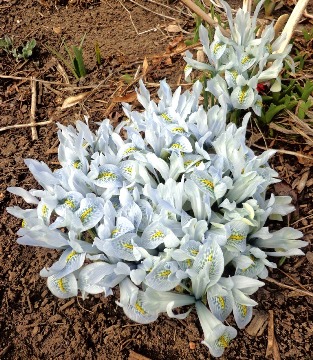 Iris 'Katharine Hodgkin' In the last few weeks, a few crocuses here...a few snowdrops there...it's been slim pickens! But suddenly with the last few warm days the Gardens are practically exploding: each day brings dozens more flowers. I've seen the first daffodils blooming gloriously inside the Mordecai Children's Garden as well as on the parking berm. Waterlily tulips are opening up everywhere. There are Magnolias opening up around town, Cornelian cherries are at their peak and the apricots and almonds and other early Prunus are teasing their first buds open. Soon we will have the whole nine-yards--Spring in her full glory parading everywhere. This magic moment, just before the figurative floodgates burst--this is perhaps the most perfect moment of the year. The garden is cleaned up and everything is shiny and promising and new. And this is the time when the glorious throng of reticulate irises are bursting into bloom here and there throughout Denver Botanic Gardens.
Iris 'Katharine Hodgkin' In the last few weeks, a few crocuses here...a few snowdrops there...it's been slim pickens! But suddenly with the last few warm days the Gardens are practically exploding: each day brings dozens more flowers. I've seen the first daffodils blooming gloriously inside the Mordecai Children's Garden as well as on the parking berm. Waterlily tulips are opening up everywhere. There are Magnolias opening up around town, Cornelian cherries are at their peak and the apricots and almonds and other early Prunus are teasing their first buds open. Soon we will have the whole nine-yards--Spring in her full glory parading everywhere. This magic moment, just before the figurative floodgates burst--this is perhaps the most perfect moment of the year. The garden is cleaned up and everything is shiny and promising and new. And this is the time when the glorious throng of reticulate irises are bursting into bloom here and there throughout Denver Botanic Gardens. 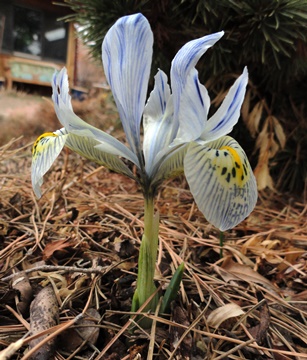 closeup of Iris 'Katharine Hodgkin' If you grow but one reticulate iris, may I recommend 'Katharine Hodgkin'? I tell her full story elsewhere more expansively. Because she is a hybrid between two rather distinct species, she possesses what botanists call heterosis, or hybrid vigor. She has formed wonderful clumps in the O'Fallon Perennial Walk that are in peak form right now. Our horticulturists have planted her liberally throughout both sides of York Street, so expect her to be ever more evident in future years. If you look carefully at this closeup, you will see some streaking. Undoubtedly due to some of the genes between the two parents struggling, as it were, in the offspring (either that, or perhaps a virus. I hope it's the family squabble rather than the latter!). Here are pictures of the two parents:
closeup of Iris 'Katharine Hodgkin' If you grow but one reticulate iris, may I recommend 'Katharine Hodgkin'? I tell her full story elsewhere more expansively. Because she is a hybrid between two rather distinct species, she possesses what botanists call heterosis, or hybrid vigor. She has formed wonderful clumps in the O'Fallon Perennial Walk that are in peak form right now. Our horticulturists have planted her liberally throughout both sides of York Street, so expect her to be ever more evident in future years. If you look carefully at this closeup, you will see some streaking. Undoubtedly due to some of the genes between the two parents struggling, as it were, in the offspring (either that, or perhaps a virus. I hope it's the family squabble rather than the latter!). Here are pictures of the two parents: 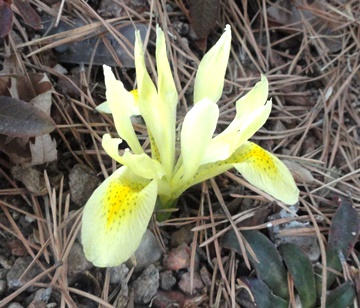 Iris winogradowii Surely the rarest, and one of the most mythical of all iris is this, the yellow reticulata cousin from the Caucasus. Now listed in the IUCN Red Book of endangered species, this is only found in a tiny part of an alpine mountain range--only a few hundred plants persisting in nature. Fortunately, there are thousands in cultivation (you can even buy them mail order rather reasonably!). If you do choose to spend a few hundred dollars on these, be aware that this species needs a rather rich, acid soil in part shade that never dries out. This is not for the beginner!
Iris winogradowii Surely the rarest, and one of the most mythical of all iris is this, the yellow reticulata cousin from the Caucasus. Now listed in the IUCN Red Book of endangered species, this is only found in a tiny part of an alpine mountain range--only a few hundred plants persisting in nature. Fortunately, there are thousands in cultivation (you can even buy them mail order rather reasonably!). If you do choose to spend a few hundred dollars on these, be aware that this species needs a rather rich, acid soil in part shade that never dries out. This is not for the beginner! 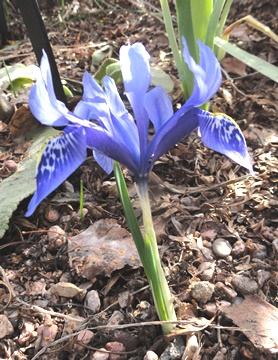 Iris histrioides 'Major' Here is the other parent: Iris histrioides is only known from a few mountain summits in Turkey, but has been grown and distributed by Dutch nurseries for almost a hundred years. We have had it for over twenty years in the Rock Alpine Garden where this was photographed a few years ago. I regard this as the most sumptuous and magnificent of the reticulate species. Alas, it is hard to find nowadays in catalogs and does not always perform well in many people's gardens. So you may have to settle for one of the dozens of true Iris reticulata, which are pretty wonderful as well.
Iris histrioides 'Major' Here is the other parent: Iris histrioides is only known from a few mountain summits in Turkey, but has been grown and distributed by Dutch nurseries for almost a hundred years. We have had it for over twenty years in the Rock Alpine Garden where this was photographed a few years ago. I regard this as the most sumptuous and magnificent of the reticulate species. Alas, it is hard to find nowadays in catalogs and does not always perform well in many people's gardens. So you may have to settle for one of the dozens of true Iris reticulata, which are pretty wonderful as well. 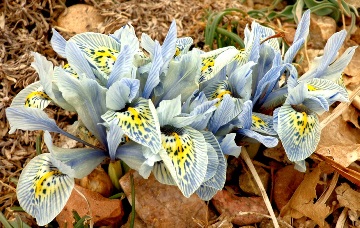 I am intrigued how 'Katharine Hodgkin' manages to transform the dark blue of histrioides into a translucent, azure sea blue-green. The yellow qualities of winogradowii are expressed through the chartreuse undertone and those wonderful golden patches. In painting, blue and yellow produce green--things are a tad more subtle and complicated in flowers. There are other hybrids gaining currency in the trade, but 'Katharine Hodgkin' seems thus far to be the most subtle combination and most readily available.
I am intrigued how 'Katharine Hodgkin' manages to transform the dark blue of histrioides into a translucent, azure sea blue-green. The yellow qualities of winogradowii are expressed through the chartreuse undertone and those wonderful golden patches. In painting, blue and yellow produce green--things are a tad more subtle and complicated in flowers. There are other hybrids gaining currency in the trade, but 'Katharine Hodgkin' seems thus far to be the most subtle combination and most readily available. 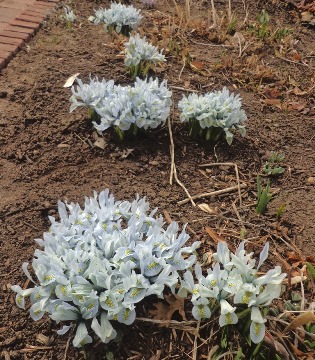 I finish the blog with a glimpse of the enormous clumps of this you can find throughout the O'Fallon Perennial Walk here and there this week. I am dazzled to see how many different bulbs have been packed into this garden by previous horticulturists, and how well they have persisted despite the intense planting in this amazing garden. I know these massive clumps have inspired me to plant lots of this terrific bulb in my garden. What better way to celebrate spring as it shifts into high gear! vroom Vroom VROOOOOOOM!
I finish the blog with a glimpse of the enormous clumps of this you can find throughout the O'Fallon Perennial Walk here and there this week. I am dazzled to see how many different bulbs have been packed into this garden by previous horticulturists, and how well they have persisted despite the intense planting in this amazing garden. I know these massive clumps have inspired me to plant lots of this terrific bulb in my garden. What better way to celebrate spring as it shifts into high gear! vroom Vroom VROOOOOOOM!
Add new comment